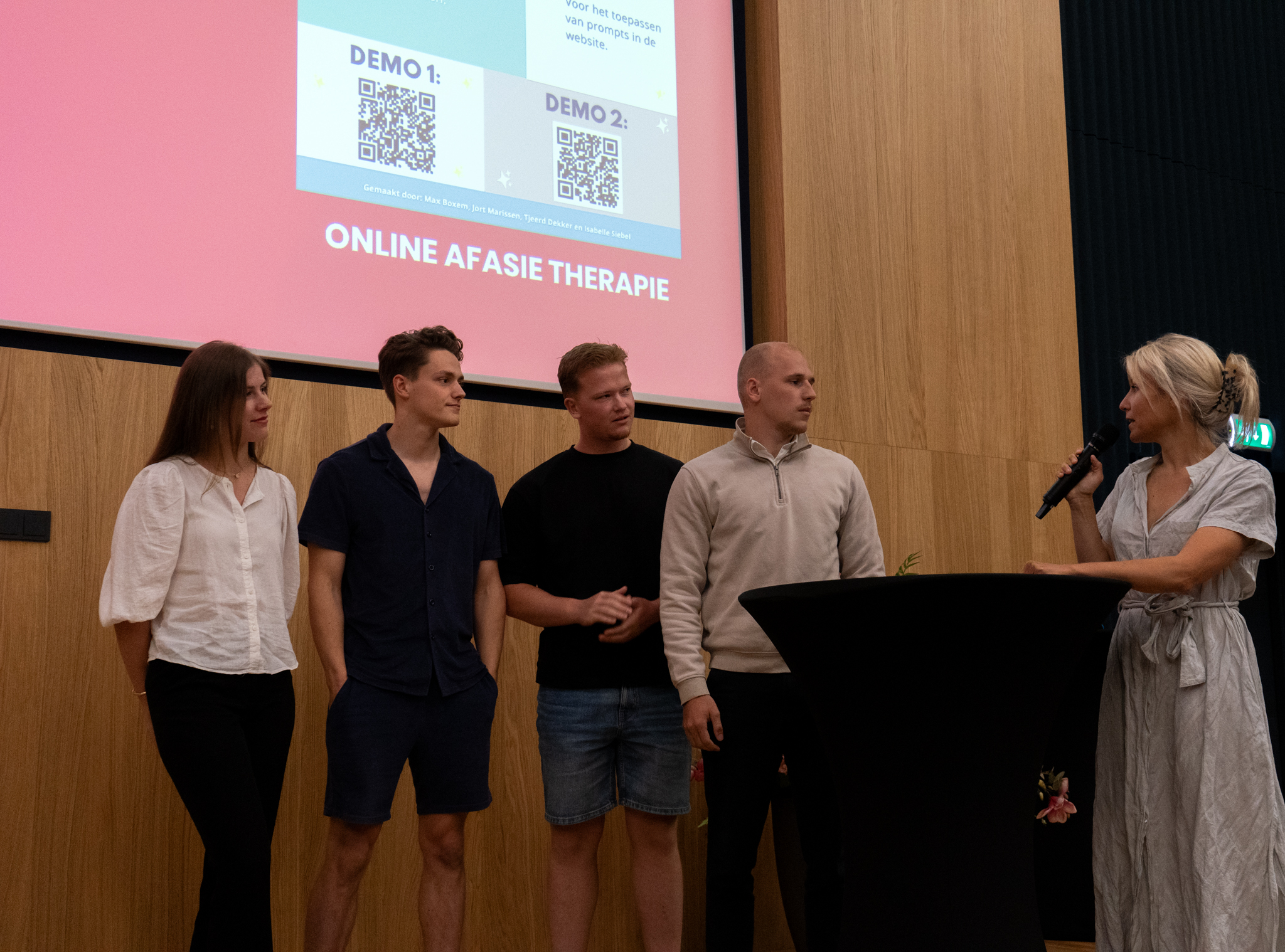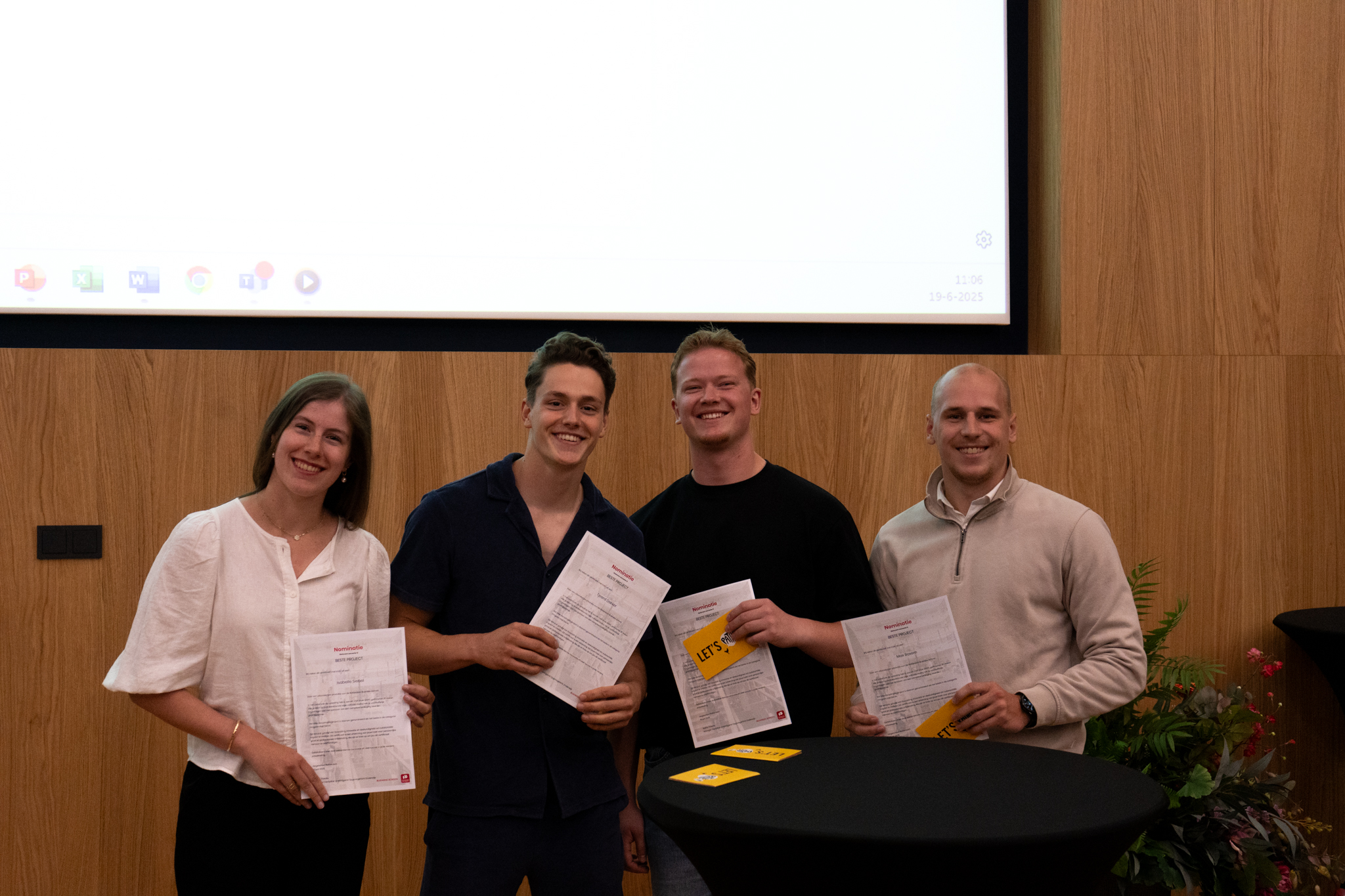During the Semester 6 programme, students work on various projects in collaboration with practice partners, addressing different themes. This is the practical implementation of Discipline-Crossing, Task-Oriented Education (DOO). Thanks to the collaboration between practice partners, researchers, and lecturers, students have the opportunity to make real impact and push their own boundaries.

Dealing with AI
One of the programmes is Dealing with AI. Four students from different programmes — Isabelle, Jort, Tjeerd, and Max — worked together with researcher Jan Pons from the Knowledge Centre Business Innovation. Using AI, they focused on online aphasia therapy.
Aphasia is a language disorder caused by acquired brain injury. Recovery requires intensive practice on areas where patients can improve, explains Jan. Speech therapists determine these areas through testing and provide exercises tailored to the patient’s needs.
Jan posed the challenge of making these exercises more efficient on an online platform using AI. Students from Rotterdam Business School explored the possibilities of AI and built their own website around it. Using AI, they generate new exercises for patients based on existing exercises provided by speech therapists. These exercises also include images created by AI models for support, as some patients learn better visually, explains Max.
A major advantage is that patients can now practice independently at home, making it easier to work on their recovery. Jan sees great potential: “We are doing this now for people who have lost their language, but there is also a large group of children with a disorder who need to learn something they haven’t mastered yet. The same system can be used there; AI can greatly help improve therapy.”
Before starting on the website and exercises, the students conducted research. By talking to patients and speech therapists, they learned what aphasia exactly entails. “Interviews with speech therapists were fairly easy, and we prepared a questionnaire. With aphasia patients it was harder — you notice they feel insecure and need to be put at ease,” Jan adds. “It’s already an achievement that they conducted these interviews at all; it requires a lot of perseverance.”

Impressed by the Students
The project itself is a success, creating social and organisational impact while enriching the students’ experience. Jan is impressed by how quickly the students grasped the challenge. They conducted research, visited the target group, and immediately started practical work. They also carefully incorporated feedback and communicated their choices clearly. “You could see that they genuinely enjoyed collaborating as a group, which was great to see,” says Jan.
The students themselves were also very enthusiastic. The further they progressed, the more questions arose. “To keep it realistic and reach a final product, we had to occasionally hit the brakes, but thankfully we had Max, and in the end, everything worked out,” says Tjeerd.
Collaboration
During the Semester 6 programme, students from different programmes come together in one group. This allows them to learn from each other and combine different expertise to create a better end product. Initially, they had to figure out each other’s strengths, but soon they complemented each other well. “I’m not strong in finance, so I was glad someone else was. That allowed me to focus on marketing,” says Isabelle.
Collaboration with Jan also went smoothly. The students worked in three phases, meeting regularly for interim discussions to review progress and expectations. This allowed the platform to evolve into a final product everyone is proud of.
These discussions between students and the client are crucial. “At first, we had to figure out what we could contribute and what Jan really wanted. But by staying in dialogue and asking questions, you eventually create a great final product that everyone is happy with. We didn’t expect to deliver a working website, but now it’s up and running,” says Jort.

Making Social Impact
Jan is very satisfied with the collaboration: “This is the future. I see it as socially important, and from my role at the university, it’s valuable to help students advance in their careers. I hardly had to provide any guidance. The best part is that these four young people will go into the world with valuable experience. They’ve shown how education, technology, and social impact can go hand in hand,” he says proudly.
Working with real clients is not only useful for the professional field, but also very interesting for students. “The most fun and interesting part was working directly with the client. You learn the most when you are actually working with AI,” explains Isabelle.
For the students, it was not only educational but also meaningful to work on a social project. “It feels better to do something for people with aphasia than to make a chatbot for an accountant or sales company. I think this impact motivated us more to really make something good of it,” says Tjeerd.
Want to know more? Contact Jan Pons.
